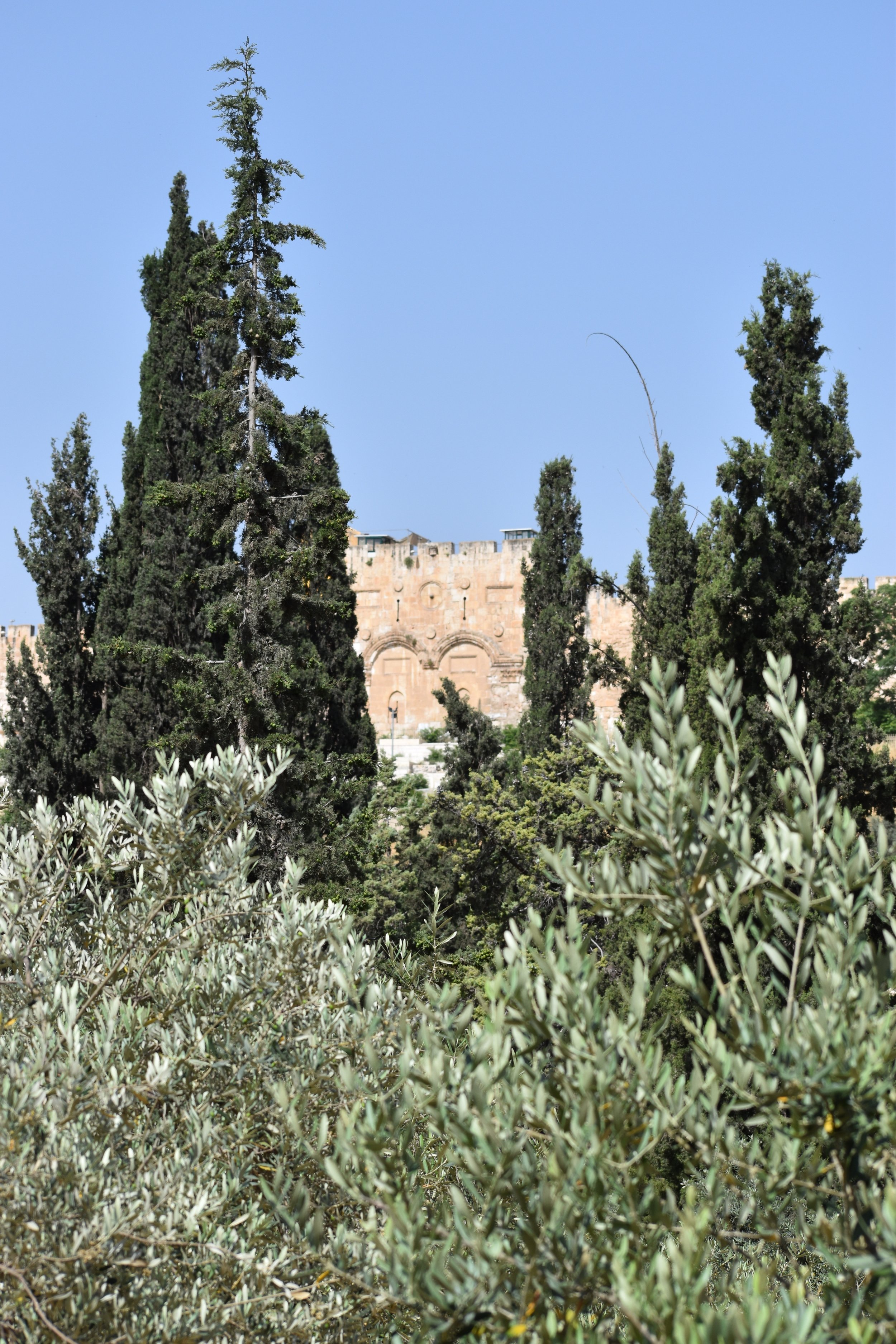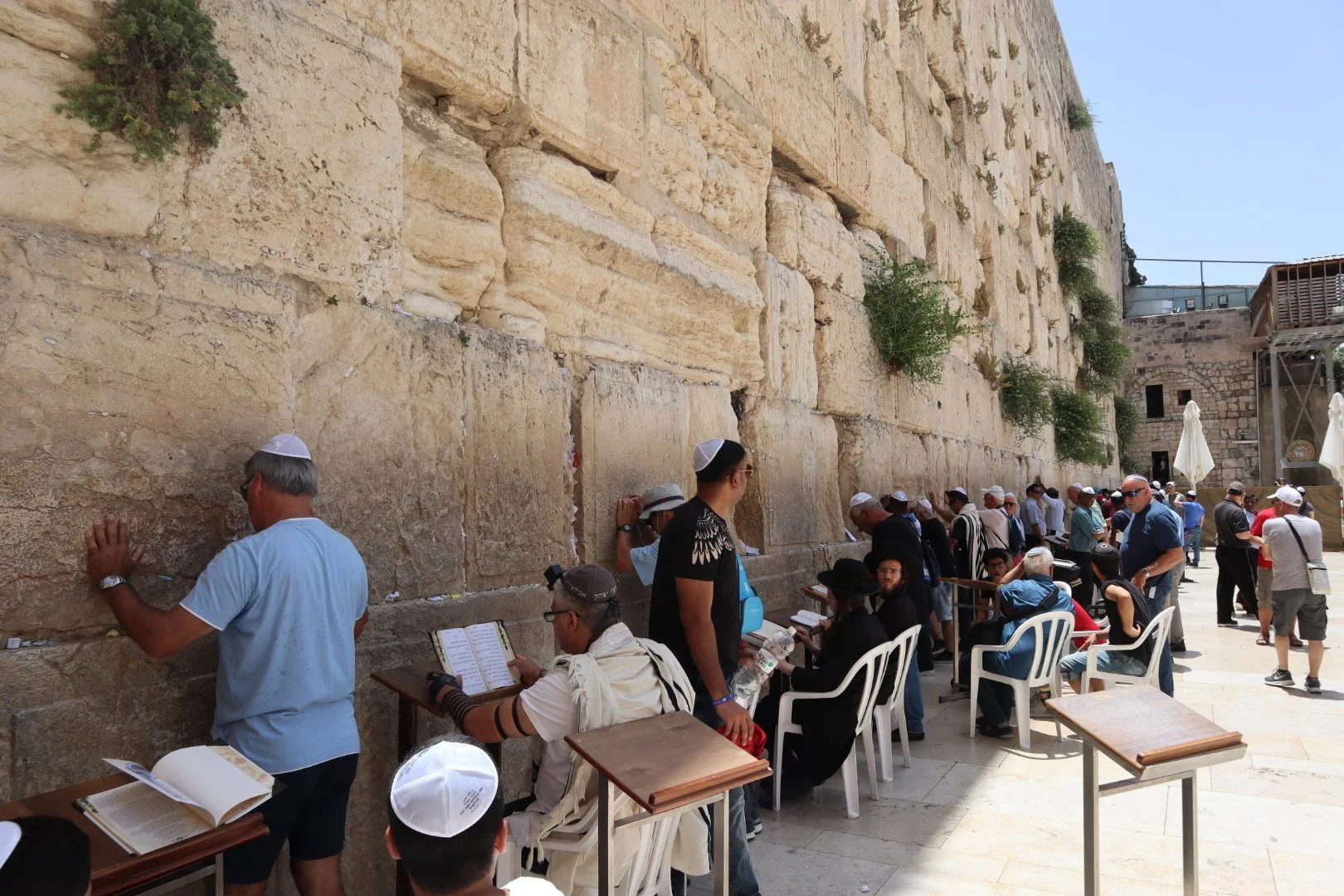A Day in Jerusalem
*Originally written for Rick Bragg’s creative writing class at UA
The Eastern Gate looked like a limestone sentry waiting for an army to crest the top of the green-and-white mountain. I could see most of the Old City from where I stood on the western ridge of the Mount of Olives, the place Jesus supposedly rode into Judea’s capital on a donkey. They say when he saw the city he began to cry, like a mother attending her son’s funeral.
One hundred fifty thousand graves cover the mount's southwest side like a blanket draped across the foot of a bed. The northwest portion is striped with the groves of olive trees that give the hill its name. Graves and trees, reminders of death and life in Jerusalem, stare unflinchingly at the Eastern Gate, where the promised Messiah is supposed to enter his city.
As we walked down the windy road toward Jerusalem, a Nigerian group of Christians passed us, banging handheld drums and singing praises to God. When my dad heard their song, his eyes filled with tears. We could not tell what words they were saying, but I like to think they were crying out, “Hosanna, Hosanna.”
When we arrived at the garden of Gethsemane, I sat down to rest my back against a thick olive tree at least ten times my age. I could barely see the Eastern Gate now due to the cypress trees planted beside the street below. When Jesus lived, those trees did not exist. Somebody planted them to adorn a holy spot for tourists like me. I knew the Galilean rabbi, the one I call “Lord,” would have been able to see the gate clearly from this spot in the olive grove two thousand years ago.
We had the garden all to ourselves for an hour. I took out my bible and tried to honor the moment by reading the words born of Jesus’ despair. When I finished, I looked up at the cypresses and closed my eyes. He would have been able to see the torches of three hundred Roman soldiers pouring out of the gate in the dark, like an army of ants flowing indignantly from their hill. I tried to imagine what he would have felt, but the gentle wind and the sway of the olive branches made it seem like the garden could never be anything but a place of peace.
The gate through which Jesus entered Jerusalem that night, bound in chains, was strong and defiant. The gate I saw with my eyes looked old and tired. Its passageways had been filled in with cement, as if to be a proclamation from the city herself that the Messiah had not come.
I was one of the 4.5 million people who visited Jerusalem in 2019. I went to see the center of the religious world, the holy city of Judaism, Islam, and Christianity. According to the scriptures of all three, Jerusalem is the place where the world will be made right, where God will make heaven come down, where a river will flow from its center and bring justice, peace, and prosperity to the ends of the earth.
And yet today, Jerusalem is a place not of peace but of division. The animosity between religions and races within its walls can be as vicious as a pack of starving wild dogs fighting over the carcass of a newborn calf.
But the city was pregnant with hope on the day Jesus rode into Jerusalem on a donkey. The king had crested the hill. Yet, only thirty-seven years later, the same hill would be a spot for onlookers to watch Jerusalem be consumed by billows of black smoke and a fire that seemed to be sentient. The Roman army ransacked the town and destroyed the center of the world. Heaven had apparently not come; Jerusalem looked more like hell.
And yet, millions of people around the world hold out hope that the Messiah—Israel’s promised, anointed ruler—will come back to Jerusalem, enter through the Eastern Gate, and make all things right. They bank their lives on it.
When we finished our time in Gethsemane, my tour group and I walked up a hill to enter the city through a gate north of the filled-in Eastern Gate. The Old City, bound by the stone walls, is not very big. It is easily walkable, taking up only about 0.35 square miles—about a quarter of the size of Central Park.
Overflowing on the sides of crowded streets within the city were vendors selling spices, clothes, toys, jewelry, pottery, and souvenirs—anything tourists would buy. The fragrance of chili powder assaulted my nostrils and seemed to take the place of oxygen.
As we made our way through the city, we visited spots of biblical significance. At one stop, my friend Keith began to speak with a Jewish man who said he lived in Jerusalem year-round. He was not an orthodox Jew, a fact made clear by his Western-looking apparel and lack of head covering. He talked about Jerusalem with a kind of fondness.
My friend, known for boldness, eventually asked the man, “So, are you waiting on the Messiah? When do you believe he’s coming?”
“We don’t care about the Messiah anymore,” said the man with a shrug of defiant indifference. “That was a thing of the past; it doesn’t matter anymore. We don’t believe any Messiah is coming.”
“Then what are you hoping for?” asked Keith.
The man was quiet for a few seconds as he tilted his head to look towards the ground.
“I think our hope is that one day God will bring all of the Jewish people back to Jerusalem again. That way, we can worship God together as one people, the way it should be.”
He and Keith talked for a few more minutes, and I listened closely in the background. When he left I could not help but feel sad. I thought about Jesus on the donkey. Before I knew it, we were moving again.
When we arrived at the Western Wall, we saw hundreds of Orthodox Jewish men swaying back and forth before the limestone wall like toy-drinking birds. The wall stands as the west side of the retaining wall that holds up the Temple Mount, the place where the Jewish Temple once towered over Jerusalem. Adherents to Judaism believe it to be the closest people can get to the destroyed temple, where the presence of God used to rest.
The cracks between the limestone blocks making up the wall were stuffed with hundreds of pieces of paper—written prayers hoping for unique access to God through closer proximity to divine space. Most of the pieces of paper were disfigured from being pushed violently into the wall, making them look like pieces of gum stuck to the bottom of a middle schooler's desk.
One praying man stood out to me among the rest. His sideburns were over a foot long, curling down to his chest like a brown twisted ribbon. He wore a black top hat and a black suit. He prayed with his eyes closed and his mouth wide with a smile. He was reciting something in Hebrew and swaying side-to-side, not forward and backward like his counterparts. He looked utterly unaware of any other people. He stood inches away from the wall as if threatening to lean in and kiss the limestone.
He was a Hasidic Jew, meaning he belonged to a conservative group of orthodox Jews who interpreted the Jewish scriptures ultra-literally. Like me, he believed the Messiah would come to free Jerusalem once and for all. He believed the city was waiting in vain.
It took me a few seconds to realize the man looked like me. He looked like me if I had sideburns, a hat, and a suit. He prayed like I did, not in the sense of his closed eyes, wide smile, or methodic sway, but with hope. I could see it on his face as if looking in a mirror.
Immediately a sense of grief hit me, like a fever breaking in reverse.
“If his hope is in the right place,” I thought, “then mine is not. If mine is correct, then his is false. If we both hold fast to what we believe—if we are faithful to our beliefs about God, the world, and life itself—then we must believe the other is wrong.”
I left the Western Wall with a pit in my stomach. In an hour I had met two Jewish men with two kinds of hope, and neither had been the same as mine. I put my head down and continued on the road with my group.
We passed broken limestone slabs the size of sports cars lining the sides of the road. Our tour guide said they were debris from the first-century wall, unmoved since the Romans knocked them from their lofty places overlooking the city. He told us they were the stones Jesus said would be overturned if Jerusalem did not believe he was the long-awaited King.
“Daughters of Jerusalem, do not weep for me, but weep for yourselves and for your children,” Jesus said to the women crying in the streets as he carried on his back the vessel of his own torture. Thirty-seven years later, those women would be slaughtered in the streets of Jerusalem by the same Roman army, being too old to be sold into slavery with their children.
In 70 CE, the Romans scraped Jerusalem down to the bone, much like they did to Jesus when they scourged the flesh off his back with a bone-tipped whip. They burned the city’s buildings, tore down her walls, and destroyed her temple. They mocked her the same way they mocked Jesus when they shoved the crown of thorns down on his head and called him a king. Fake kingdom, they declared over Jerusalem. Fake king, they said over the man.
We continued on our way, walking the path Jesus followed to his execution. It was night when we entered the Church of the Holy Sepulchre, traditionally held to be the spot of Jesus’ crucifixion and burial. The church was dark and somber; it felt like a funeral ceremony that began two thousand years ago and never ended. I walked up to see the rock wall where they believe Jesus was lifted up on the wooden beam.
The place I stood was where his mother would have screamed when she watched her son pull himself up with his nail-pierced wrists so he could breathe another breath of air. Storm clouds began to form in the sky above while those going in and out of Jerusalem saw him and laughed. They knew kings did not get crucified.
And then—as if to speak for and against the city at the same time—Jesus lifted himself up again and yelled in a loud voice, “My God, my God, why have you forsaken me?” And everyone went quiet.
When he died, the clouds gave way to rays of sunlight that hit Jerusalem’s limestone walls and the skin of the dead man’s body—the walls that would soon come crumbling down and the body that, one way or another, would in three days change the world.
I opened my eyes and walked over to the Edicule, where Catholic clergymen had reconstructed Jesus’ tomb. I ducked to enter the chamber and knelt beside the spot where they said his dead body was laid.
“I believe, Lord,” I prayed. “Help me believe.”
By the time I started walking back to our hotel, the vendors were no longer in the streets. The moonlight lit up the stone walkway leading out of the Old City into the modern section of Jerusalem. I turned around to see the limestone walls buffering the city from the rest of the world. As I walked away, I wondered if I would ever see them again.



